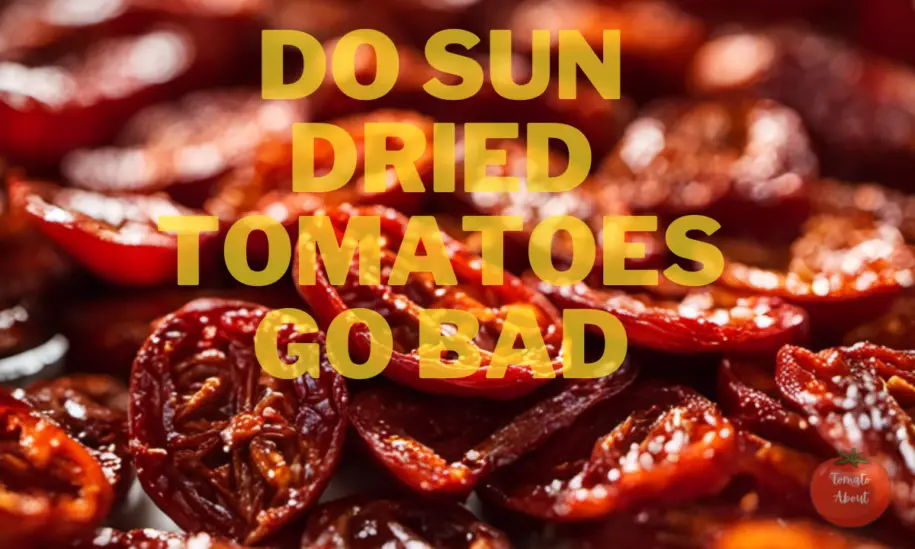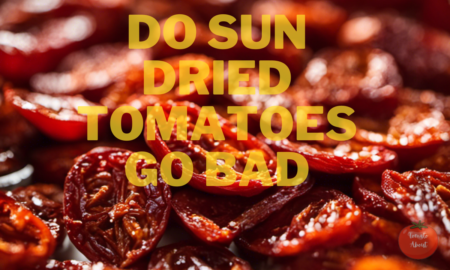Key Takeaways
- Sun-dried tomatoes can go bad, and their shelf life depends on the type.
- There are three main types of sun-dried tomatoes: sun-dried, oven-dried, and oil-packed.
- Properly dried sun-dried tomatoes can last 6 months at room temperature, 1 year in the fridge, or 1-2 years when frozen.
- Avoid moisture and air exposure to maintain the quality of sun-dried tomatoes.
- Sun-dried tomatoes packed in oil should be used within 3-4 months when refrigerated.
Picture it – you’re making a batch of homemade pasta sauce and reach for a jar of sun-dried tomatoes. But you realize it’s been sitting in the pantry for months. Now you’re wondering, do sun-dried tomatoes go bad?
With their intense, concentrated flavor and chewy texture, these umami-packed morsels are a pantry staple. But sun-dried tomatoes have a reputation for longevity.
This guide will cover how shelf life varies for different types, signs of spoilage, and tips for maximizing freshness. Read on to learn if and when sun-dried tomatoes go bad.
Sun-Dried Tomatoes
Before diving into storage methods, let’s first understand what exactly sun-dried tomatoes are.
Sun-dried tomatoes are fresh tomatoes that have been sliced and dried, either in the sun or in a food dehydrator. This drying process removes the moisture from the tomatoes, concentrating their flavor and changing their texture.
These are most common tomato variety used is the plum tomato. These oval-shaped tomatoes have thicker flesh and less moisture, making them perfect candidates for drying.
Other tomato varieties like cherry, grape, and Roma tomatoes can also be sundried with great results. Their sweeter flavor becomes even more pronounced when dried.
Sun-dried tomatoes are quite different from regular dried tomatoes. Regular dried tomatoes are mechanically dehydrated at high temperatures. Sun-dried tomatoes are slowly dried at temperatures below 145°F, preserving more nutrients and flavor.
The slow drying process gives sun-dried tomatoes an intense umami, almost salty taste. Their texture becomes chewy yet rigid. Rehydrating sun-dried tomatoes in water or oil softens them up again.
An Overview of Sun-Dried Tomato Types
Not all sun-dried tomatoes are created equal when it comes to shelf life. There are three main forms:
Sun Dried
These are raw tomatoes that have been sliced and dehydrated until all moisture has evaporated. water activity level. They may be blanched or soaked in oil prior to drying. True sun-dried tomatoes are stiff and leathery.
Oven Dried
Oven-dried tomatoes are also made from fresh raw tomatoes slowly dehydrated in a low oven until shriveled. They have a similar texture and moisture level to sun-dried.
Oil Packed
The most common commercial variety, oil-packed sun-dried tomatoes are semi-dried tomatoes plumped back up by packing in olive oil and spices. The oil helps preserve and extend the shelf life.
Now let’s look at how long each type keeps when properly stored.
How Long Do Sun Dried Tomatoes Last?
With the right storage methods, sun-dried tomatoes can stay fresh for:
- True Sun Dried – 6 to 12 months
- Oven Dried – 4 to 10 months
- Oil Packed – 10 to 18 months
The key factors that affect shelf life are moisture content, exposure to air, temperature, and light. Follow proper storage guidelines to get the maximum duration.
Do Sun Dried Tomatoes Need Refrigeration?
Because they are low in moisture, sun-dried tomatoes do not require refrigeration. In fact, the cold dampness of the fridge can actually encourage mold growth.
Pantry storage is ideal for both commercial and homemade dried tomato varieties.
Where to Store Sun-Dried Tomatoes
Keep dried tomatoes in a cool, dark place in an airtight container. The optimal storage temperature is below 65°F. The fridge is OK short-term, but not for prolonged storage.
Dry areas with stability temps like pantries and root cellars are perfect.
Opened vs. Unopened Sun-Dried Tomatoes
Once opened, shelf life decreases due to exposure to air, light, and contamination. Store opened jars in the fridge and use within:
- Oil Packed – 3 to 4 weeks
- Sun Dried – 2 to 3 weeks
Unopened jars keep much longer – up to the durations listed previously.
Now let’s look at how to identify if your sun-dried tomatoes have gone bad.
How To Know If Sun-Dried Tomatoes Have Spoiled
With their low moisture content, sun-dried tomatoes seem like they should resist spoiling indefinitely. But they still eventually go bad. Here’s a more detailed explanation of how to identify spoiled sun-dried tomatoes:
Mold Growth – The most obvious sign is fuzzy green, white, or black mold growing on the tomatoes. This indicates spoilage fungi have taken hold due to excess moisture. Discard any sun-dried tomatoes with mold immediately.
Soft Texture – Properly dried sun-dried tomatoes will feel leathery or crisp. A soft, mushy texture means they have absorbed moisture, promoting bacterial growth and decomposition. This can create an unpleasant, slimy rotten texture.
Strong Sour Smell – Good dried tomatoes have an intense umami, almost salty fragrance. A pungent sour, acrid or rotten odor strongly indicates spoilage bacteria are breaking down the tomatoes.
Dull or Faded Color – Ideal dried tomatoes retain their rich, deep red color. Brown, grey, or faded dull color usually means the tomatoes have oxidized from moisture exposure. It also signals they may be spoiled.
Condensation in Jar – Excess moisture collecting at the bottom of the storage jar is a clear sign the tomatoes did not dry thoroughly before packing. This moisture enables mold growth and quicker spoilage.
Following proper storage methods prevents moisture and oxygen from creating these conditions. But eventually, even stored sun-dried tomatoes will show signs of going bad.
How Long Do Dried Sun-Dried Tomatoes Last?
With the right storage, properly dried sun-dried tomatoes can last:
- 6 months at room temperature.
- 1 year refrigerated.
- 1-2 years frozen.
Sun-dried tomatoes packed in oil instead of fully dried will last 3-4 months refrigerated.
The key is starting with tomatoes dried down to at least 70% moisture removal, ideally 50% or less. Research shows tomatoes dried in a dehydrator or oven also tend to last longer, up to 2 years refrigerated, compared to air-dried varieties that may only last 6-12 months.
| Type of Sun-Dried Tomatoes | Shelf Life (in cool, dry pantry) | Shelf Life (in refrigerator) | Factors that may affect shelf life |
|---|---|---|---|
| Plain Sun-Dried Tomatoes | Up to a year | Up to a year | Light and heat |
| Oil-Packed Sun-Dried Tomatoes | 6 to 8 months | 6 to 8 months | Temperature and humidity |
| Store-Bought Sun-Dried Tomatoes | Varies (check expiration date on package) | Varies (check expiration date on package) | Temperature and humidity, added preservatives |
Now let’s look at storage methods to maximize shelf life.
Storing Sun sun-dried tomatoes at Room Temperature
Storing dried tomatoes at room temperature works, but they must have very low moisture content. Follow these tips for the best quality:
- Dry tomatoes in a dehydrator or oven until brittle, about 50% moisture removal.
- Pack dried tomatoes in an airtight glass or plastic container immediately after drying. Mason jars work perfectly.
- Include a silica gel packet or two inside the jar to absorb any moisture. You can find these with other canning supplies or in medication bottles.
- Store the jar in a cool, dark cupboard away from heat and light.
- Check tomatoes every few months for signs of spoilage. Discard if you see moisture, sliminess, or mold.
- For the best flavor, use within 6 months. Refrigerate any jars not finished by this time.
The key is keeping moisture out. Any humidity inside the storage container quickly reduces the dried tomato quality. An airtight jar prevents ambient humidity from seeping in.
Refrigerating Sun-Dried Tomatoes
Refrigerating your dried tomatoes is the best way to extend their shelf life up to a year. Follow these guidelines:
- Dry tomatoes until leathery but still pliable, around 70% moisture removal. Don’t overdry.
- Pack dried tomatoes in an airtight glass or plastic container. Leave no air gaps.
- Optional: Cover tomatoes fully with a layer of extra virgin olive oil. This prevents oxidation and adds flavor.
- Seal and store the container in the refrigerator. Use within 1 year.
- Check periodically for moisture or spoilage. Discard if tomatoes become mushy or moldy.
The cold temperature inside the fridge slows down microbial growth and oxidation. This preserves texture and flavor longer. Olive oil as a barrier also protects against fridge odors.
Freezing Sun-Dried Tomatoes
Freezing extends storage life even further to 1-2 years. It stops enzyme activity and microbe growth completely. Here’s how:
- Dry tomatoes to 70% moisture content. Don’t overdry, as texture suffers when frozen.
- Line a baking sheet with parchment paper or a silicone mat. Arrange tomatoes in a single layer without touching them.
- Place the tray of tomatoes in the freezer until completely hardened, about 1 hour.
- Transfer frozen tomatoes to an airtight freezer bag or container. Exclude as much air as possible.
- Store tomatoes in a freezer set at 0°F or below. Use within 1-2 years for best quality.
- Don’t thaw before using. Rinse under cool water briefly to remove any ice crystals if needed.
The initial fast freezing prevents large ice crystals from forming and damaging the tomato cell structure. Maintaining frozen storage stops any further deterioration.
Storing Sun Dried Tomatoes Packed in Oil
Many commercial sun-dried tomatoes come packed in olive oil rather than completely dried. Shelf life is shorter but it’s easy:
- Purchase high-quality sun-dried tomatoes packed in oil in jars or vacuum-sealed pouches.
- Refrigerate unopened jars/bags. Use within 3-4 months for best quality.
- Transfer any remaining oil-packed tomatoes to an airtight container after opening. Add fresh olive oil to cover if needed.
- Always refrigerate opened jars and use them within 1 week. Discard if you see any mold.
The olive oil helps retain texture but also promotes bacterial growth when exposed to air. Refrigeration and using opened jars quickly avoids this.
What’s the Best Way to Dry Sun Dried Tomatoes?
While you can dry tomatoes in the sun, using a dedicated dehydrator or oven is best. These methods give you complete control over the drying conditions for perfect results every time. Here are some dos and don’ts:
DO:
- Wash and slice tomatoes 1/4 to 1/2 inch thick. Less moisture means faster, more even drying.
- Dry at 130-140°F until tomatoes are leathery. This maintains flavor and texture.
- Rotate trays and shift tomatoes around for uniform drying.
- Allow tomatoes to cool fully before packing them into storage containers.
DON’T:
- Leave whole tomatoes or thick slices – uneven drying will result.
- Dry tomatoes above 145°F temperatures – higher heat damages flavor.
- Bundle tomatoes touching each other – this prevents effective moisture removal.
- Seal tomatoes that feel moist or flexible – only pack completely dried tomatoes.
With the right drying and storage methods, you can enjoy flavor-packed sun-dried tomatoes for many meals to come. Just be diligent in checking jars for any signs of moisture or spoilage. A little attention ensures you’ll never have to toss these delicious fruits.
Read my detailed article on storing tomatoes.
Frequently Asked Questions
1. Can you eat spoiled sun-dried tomatoes?
No, you should not eat sun-dried tomatoes with mold, off smells, or other signs of spoilage. The bacteria and toxins that cause food spoilage can cause food poisoning if ingested. Always discard spoiled sun-dried tomatoes.
2. How do you rehydrate sun-dried tomatoes?
To rehydrate sun-dried tomatoes, place them in a bowl and cover with hot water. Let sit for 15-20 minutes, then drain and use. For added flavor, you can also rehydrate in olive oil, vegetable or chicken broth, or wine.
3. Can you freeze sun-dried tomatoes in olive oil?
Yes, you can safely freeze sun-dried tomatoes stored in olive oil. Make sure the jar is tightly sealed with no air gaps before freezing. Frozen oil-packed tomatoes last 8-12 months. Thaw in the refrigerator before using.
Wrapping up
With their intense umami taste, sun-dried tomatoes are an amazing ingredient. But their low-moisture makeup also makes them prone to quick spoilage from excess humidity.
Follow these storage guidelines to keep your sun-dried tomatoes fresh for as long as possible:
- Dry tomatoes thoroughly to 50-70% moisture removal
- Store in airtight containers with silica gel packs
- Refrigerate or freeze for extended shelf life
- Check periodically for signs of moisture and mold



